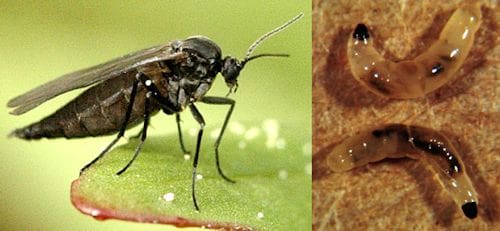
The term “fungus gnat” applies to a number of species of insects. Fungus gnat adults are a mostly a nuisance, but the larvae can damage healthy roots, stunting or killing young plants even where there is no fungal food source. Prolonged infestations may cause stunted, off-colored plants or foliage. Damage may actually be more severe to young plants when the potting media is fresh, as there is less fungus available as a food source. Fungus gnat larvae may also aid in the introduction and spread of plant diseases such as Pythium, Verticillium, Cylindrocladium, Scelerotinia and Theila-viopsis.
Symptoms:
It is very easy to detect fungus gnats, as they will become a nuisance in your growing area. If you want to be certain of your diagnosis, the use of yellow sticky traps is effective. Adult fungus gnats are small (1/8 inch long), fragile grayish to black flies with long, slender legs and thread-like antennae, looking a bit like mini-mosquitoes. Larvae are clear to creamy-white and can grow to about 1/4 inch long. They have shiny black head capsules .
Life cycle:
Fungus gnats develop through the complete metamorphosis – egg, larva, pupa, and adult – in 2 to 4 weeks. Larvae feed primarily on fungi, decaying organic matter and plant roots, particularly in very moist environments. Larval and pupal stages can also, however, survive periods of drought.
Controls:
It is important to rid your collection of both the adult and juvenile forms of the critters. Many feel that a complete spray/medium drench treatment with neem oil is effective, as it can get rid of the insects and the fungi they feed upon. Many commercial contact- and systemic insecticides are available – check the label.
My own stance is that the presence of fungus gnats is a good indicator that your medium is decomposing – the “canary in the coal mine”, as it were. Some advise letting it dry out to control the gnats, but that’s managing the symptom, not the problem. If you see gnats, it’s time to repot.